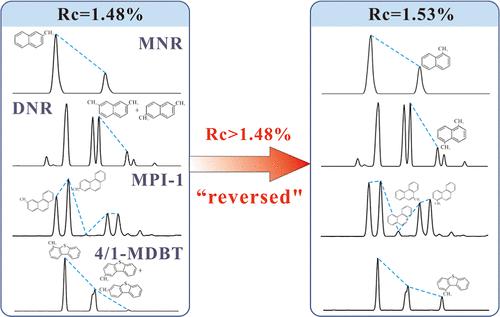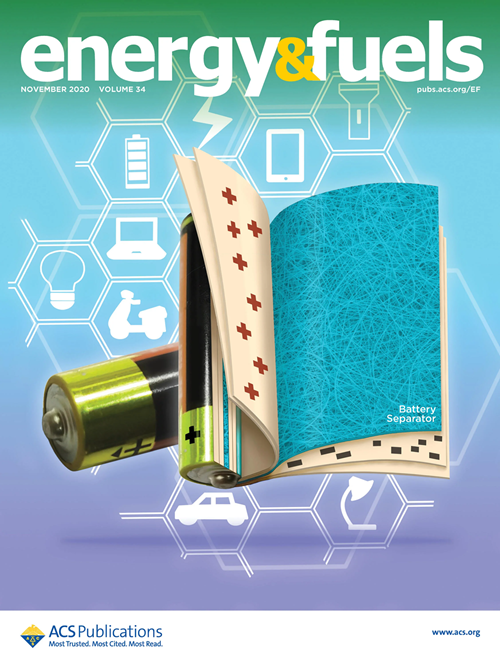超深层油藏高纯度石油中芳烃成熟度参数的适用性和局限性
IF 5.2
3区 工程技术
Q2 ENERGY & FUELS
引用次数: 0
摘要
在中国西北塔里木盆地顺北油田奥陶系储层中发现了储量可观的高度成熟轻质油。本研究旨在对顺北油田的石油成熟度进行客观评估,并为处于高热演化阶段的石油建立可靠的成熟度评价指标。18 个原油样本来自顺北油田 4 号断裂带(F4)。系统分析了顺北油田 4 号断裂带(F4)的 18 个原油样本。采用气相色谱-质谱法分析了芳香烃、轻烃组分和类金刚石成分。通过相应的地球化学指标确定了相关源岩的沉积环境和有机质输入情况。结果表明,F4 油源自同一源厨,属于同一油群。研究区的石油成熟度是通过芳烃、轻烃和菱形烃的成熟度参数来评价的。分析表明,芳烃参数在鉴定油类成熟度方面的结果与轻烃和类钻参数的结果相矛盾。油样的等效玻璃光泽反射率在 1.43% 至 1.54% 之间。由此得出结论,轻烃和类钻参数可以可靠地用于评估高热演化阶段的石油成熟度。然而,大多数芳烃成熟度参数在高温演化阶段表现出明显的局限性。在高温演化阶段,菲和二苯并噻吩的成熟度参数分别因脱甲基和热改变而发生 "逆转"。此外,大多数萘的成熟度参数都受到热诱导缩合的影响,因此不适合用于高温演化阶段的成熟度评估。值得注意的是,五甲基萘比率[PMNr,PMNr = 1, 2, 4, 6, 7-/(1, 2, 4, 6, 7 + 1, 2, 3, 5, 6)-五甲基萘]与气油比、正庚烷/甲基环己烷(nC7/MCH)比率和(3 + 4)-甲基二烷烃浓度呈现出强烈的正相关性,这表明它们是高度成熟至过度成熟油类和源岩的成熟度指标。本文章由计算机程序翻译,如有差异,请以英文原文为准。

Applicability and Limitation of Aromatic Maturity Parameters in High-Maturity Oil from Ultradeep Reservoirs
A substantial reserve of highly mature light oil has been discovered in the Ordovician reservoir of the Shunbei oilfield, Tarim Basin, Northwest China. This study aims to provide an objective assessment of oil maturity in the Shunbei oilfield and establish a reliable maturity evaluation index for oil in the high thermal evolution stage. Eighteen crude oil samples from the no. 4 fault zone (F4) of the Shunbei oilfield were systematically analyzed. Aromatic hydrocarbon, light hydrocarbon components, and diamondoid compositions were analyzed by gas chromatography–mass spectrometry. The depositional environment and the organic matter input of their related source rocks were determined by the corresponding geochemical indicators. The results indicate that the F4 oils have been derived from the same source kitchen and belong to the same oil population. The oil maturity in the study area was evaluated by the maturity parameters relative to aromatics, light hydrocarbons, and diamondoids. The analysis indicates that the results of aromatic parameters for identifying oil maturity contradict those of light hydrocarbon and diamondoid parameters. The equivalent vitrinite reflectance of the oil samples ranges from 1.43% to 1.54%. It is concluded that light hydrocarbon and diamondoid parameters can reliably be used to evaluate the maturity of oil in the high thermal evolution stage. However, most of the aromatic maturity parameters exhibit significant limitations during the high-temperature evolution stage. The maturity parameters of phenanthrene and dibenzothiophene were “reversed” in the high thermal evolution stage due to demethylation and thermal alteration, respectively. Additionally, most naphthalene maturity parameters are affected by thermally induced condensation, rendering them unsuitable for maturity evaluation of the high-temperature evolution stage. Notably, pentamethylnaphthalene ratio [PMNr, PMNr = 1, 2, 4, 6, 7-/(1, 2, 4, 6, 7 + 1, 2, 3, 5, 6)-pentamethylnaphthalene] exhibits a strong positive correlation with gas–oil ratio, n-heptane/methylcyclohexane (nC7/MCH) ratio, and (3 + 4)-methyldiamantane concentrations, indicating their reliability as maturity indicators for highly to overmature oils and source rocks.
求助全文
通过发布文献求助,成功后即可免费获取论文全文。
去求助
来源期刊

Energy & Fuels
工程技术-工程:化工
CiteScore
9.20
自引率
13.20%
发文量
1101
审稿时长
2.1 months
期刊介绍:
Energy & Fuels publishes reports of research in the technical area defined by the intersection of the disciplines of chemistry and chemical engineering and the application domain of non-nuclear energy and fuels. This includes research directed at the formation of, exploration for, and production of fossil fuels and biomass; the properties and structure or molecular composition of both raw fuels and refined products; the chemistry involved in the processing and utilization of fuels; fuel cells and their applications; and the analytical and instrumental techniques used in investigations of the foregoing areas.
 求助内容:
求助内容: 应助结果提醒方式:
应助结果提醒方式:


